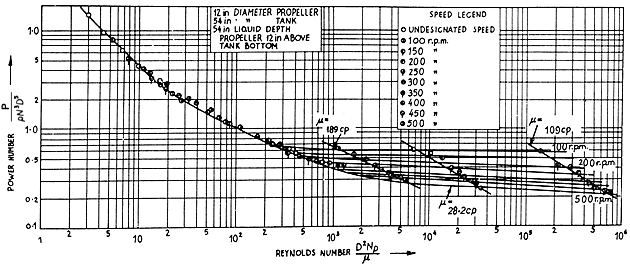The Froude number
correlates the effects of gravitational forces and it only becomes significant
when the propeller disturbs the liquid surface. Below Reynolds numbers of
about 300, the Froude number is found to have little or no effect, so that
eqn. (12.7) becomes:
(Po) = K(Re)n
(12.8)
Experimental results
from the work of Rushton are shown plotted in Fig. 12.1.

Figure 12.1 Performance of propeller mixers
Adapted from Rushton (1950)
Unfortunately,
general formulae have not been obtained, so that the results are confined
to the particular experimental propeller configurations that were used.
If experimental curves are available, then they can be used to give values
for n and K in eqn. (12.8) and the equation then used to predict
power consumption. For example, for a propeller, with a pitch equal to
the diameter, Rushton gives n = -1 and K = 41.
In
cases in which experimental results are not already available, the best
approach to the prediction of power consumption in propeller mixers is
to use physical models, measure the factors, and then use eqn. (12.7)
or eqn. (12.8) for scaling up the experimental results.
 EXAMPLE
12.6. Blending vitamin concentrate into molasses EXAMPLE
12.6. Blending vitamin concentrate into molasses
Vitamin concentrate is being blended into molasses and it has been found
that satisfactory mixing rates can be obtained in a small tank 0.67 m
diameter, height 0.75 m,with a propeller 0.33 m diameter rotating at 450
rev min-1. If a large-scale plant is to be designed which will
require a tank 2 m diameter, what will be suitable values to choose for
tank depth, propeller diameter and rotational speed, if it is desired
to preserve the same mixing conditions as in the smaller plant? What would
be the power requirement for the motor driving the propeller? Assume that
the viscosity of molasses is 6.6 N s m-2 and its density is
1520 kg m-3.
Use
the subscripts S for the small tank and L for the larger one. To preserve
geometric similarity the dimensional ratios should be the same in the
large tank as in the small.
Given that the full-scale tank is three times larger than the model,
DL = 3DS.
depth
of large tank = HL = 3HS =
3 x 0.75 = 2.25 m
and
propeller diameter in the
large tank = DL = 3DS = 3 x
0.33 = 1 m .
For dynamic similarity, (Re)L = (Re)S
(D2Nr/m)L
= (D2Nr/m)S
DL2NL
= DS2NS
NL = (1/3)2
x 450
= 50 rev min-1
= 0.83 rev
sec-1.
= speed of
propeller in the large tank.
For the large tank
(Re) = (DL2NLr/m)
so (Re)
= (12 x 0.83 x 1520)/6.6
= 191
Eqn. (12.8) is applicable, and assuming that K = 41 and n = -1,
we have
(Po) = 41(Re)-1 = (P/D5N3r)
P = (41 x 15 x (0.83)3 x 1520)/(191)
= 186 J s-1
And since 1 horsepower = 746 J s-1
Required motor = 186/746, say 1/4 horsepower.
Apart from
deliberate mixing, liquids in turbulent flow or passing through equipment
such as pumps are being vigorously mixed. By planning such equipment in
flow lines, or by ensuring turbulent flow in pipelines, liquid mixing may
in many instances be satisfactorily accomplished as a byproduct of fluid
transport.
 Mixing
> MIXING EQUIPMENT Mixing
> MIXING EQUIPMENT
 Back
to the top Back
to the top |

